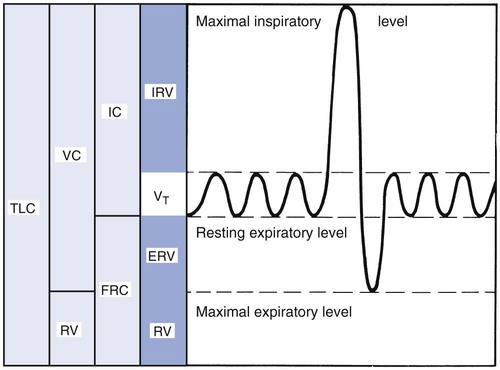1. Identify lung volumes and capacities. 2. Identify general types of instruments that measure gas volume and flow. 3. Perform calibration of volume displacement and flow-sensing spirometers. 5. Perform a forced vital capacity. Pulmonary function tests (PFTs) are used to evaluate lung volumes and capacities, rates of flow, and gas exchange. Indications for PFTs include the need to identify and quantify changes in pulmonary function; evaluate need and quantify therapeutic effectiveness; perform epidemiologic surveillance for pulmonary disease; assess patients for risk of postoperative pulmonary complications; and determine pulmonary disability. Diagnosis of pulmonary diseases commonly requires PFTs, and respiratory therapists (RTs) usually administer the variety of tests involved. Categories of these tests are given in Box 9-1. Basic diagnostic and therapeutic questions for pulmonary function testing are provided in Box 9-2. Pulmonary function tests do not diagnose specific diseases but, rather, classify patterns of impairment to include obstructive and restrictive impairments. These two types of impairments may occur together and are referred to as mixed impairment (Box 9-3). RTs need to be familiar with PFTs because these tests reveal quantitative data about a patient’s pulmonary pathology. A diagrammatic representation of lung volumes and capacities is given in Figure 9-1. The primary measuring instruments used in performing PFTs include spirometers, which measure gas volume, and pneumotachometers, which measure gas flow. Simple PFTs may be performed at the bedside or in the patient’s home. But more detailed and complex physiologic assessments need to be performed in a pulmonary function laboratory. Basic precautions for infection control during assessment are important and are outlined in Box 9-4. Most spirometers in laboratories use computer generated graphics. Testing formats include screenings, bedside testing, and complete pulmonary function survey. Criteria for acceptability for some common tests are summarized in Table 9-1. Reversibility of airway obstruction is determined by performing spirometry before and after the administration of bronchodilators. The formula used to calculate improvement is given in Box 9-5 and pretest instructions in Box 9-6. This chapter will focus on simple spirometry, forced vital capacity maneuvers, and flow-volume curves associated with airway function testing. TABLE 9-1
Pulmonary Function Testing


Thoracic Key
Fastest Thoracic Insight Engine

































